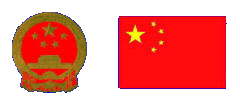Facts about
China: General Information
 China is situated in eastern Asia, bounded by the Pacific in the
east. The third largest country in the world, next to Canada and Russia, it has an area of
9.6 million square kilometers, or one-fifteenth of the world's land mass. It begins from
the confluence of the Heilong and Wusuli rivers (135 degrees and 5 minutes east longitude)
in the east to the Pamirs west of Wuqia County in Xinjiang Uygur Autonomous Region (73
degrees and 40 minutes east longitude) in the west, about 5,200 kilometers apart; and from
the midstream of the Heilong River north of Mohe (53 degrees and 31 minutes north
latitude) in the north to the southernmost island Zengmu'ansha in the South China Sea (4
degrees and 15 minutes north latitude), about 5,500 kilometers apart. The border stretches
over 22,000 kilometers on land and the coastline extends well over 18,000 kilometers,
washed by the waters of the Bohai, the Huanghai, the East China and the South China seas.
The Bohai Sea is the inland sea of China. There are 6,536 islands larger than 500 square
meters, the largest is Taiwan, with a total area of about 36,000 square kilometers, and
the second, Hainan. The South China Sea Islands are the southernmost island group of
China. China is situated in eastern Asia, bounded by the Pacific in the
east. The third largest country in the world, next to Canada and Russia, it has an area of
9.6 million square kilometers, or one-fifteenth of the world's land mass. It begins from
the confluence of the Heilong and Wusuli rivers (135 degrees and 5 minutes east longitude)
in the east to the Pamirs west of Wuqia County in Xinjiang Uygur Autonomous Region (73
degrees and 40 minutes east longitude) in the west, about 5,200 kilometers apart; and from
the midstream of the Heilong River north of Mohe (53 degrees and 31 minutes north
latitude) in the north to the southernmost island Zengmu'ansha in the South China Sea (4
degrees and 15 minutes north latitude), about 5,500 kilometers apart. The border stretches
over 22,000 kilometers on land and the coastline extends well over 18,000 kilometers,
washed by the waters of the Bohai, the Huanghai, the East China and the South China seas.
The Bohai Sea is the inland sea of China. There are 6,536 islands larger than 500 square
meters, the largest is Taiwan, with a total area of about 36,000 square kilometers, and
the second, Hainan. The South China Sea Islands are the southernmost island group of
China.
Capital: Bejing
Date of Establishment Of People's Republic
of China: October 1st, 1994
Population:
| Year |
Total Population |
Urban Population |
Rural Population |
| 1995 |
1.21121 billion |
|
|
| 1996 |
1.22389 billion |
359.5 million (29.4%) |
864.39 million (70.6%) |
| 1997 |
1.23626 billion |
369.89 million (29.9%) |
866.37 million (70.1%) |
| 1998 |
1.24810 billion |
|
|
| Year |
Birth Rate (Per
Thousand) |
Death Rate (per
thousand) |
Natural Growth Rate
(per thousand) |
| 1995 |
17.12 |
6.57 |
|
| 1996 |
16.98 |
6.56 |
10.42 |
| 1997 |
16.57 |
6.51 |
10.06 |
| 1998 |
16.30 |
6.50 |
9.53 |
The year of 1998 saw19.91 million
births, 8.07 million deaths of the population, with a net growth polulation of 11.84
million (compared with 12.37 million in 1997).
Life Spand: 70.8 years (male
= 68.71, female = 73.04)
(Some of the above data are based on the
report from China National Statistics Bureau)
Administative Divisions:
23 provinces, 5 autonomous regions, 4 municipalities
and 1 Special Administrative Region.
State Organs:
The National People's Congress (NPC)
The President of the People's Republic of China
The State Council
The Central Military Commission
The Supreme People's Court
The Supreme People's Procuratorate
Constitution
Armed Force: the People's
Liberation Army (PLA)
The Ruling Party: the
Communist Party of China (CPC)
The President: Jiang Zemin
Official Holidays:
New Year's Day (January
1), Chinese New Year's Day (Jan. or Feb.), International Women's Working Day (March 8), Arbor Day (March 12), International Labor Day (May 1), Youth Day (May 4),
International Children's Day (June 1), Anniversary of the Founding of the Communist Party
(July 1), Anniversary of the Founding of the Chinese PLA (August 1), Teacher’s Day (September 10) and National Day (October 1).
Official Language: Mandarin
(coomon speech)
Nationalities: The People's Republic of China is a unified,
multi-national country, comprising 56 nationalities. The Han people make up 91.02 percent
of the total population, leaving 8.98 percent for the other 55 ethnic minorities. They are
Mongolian, Hui, Tibetan, Uygur, Miao, Yi, Zhuang, Bouyei, Korean, Manchu, Dong, Yao, Bai,
Tujia, Hani, Kazak, Dai, Li, Lisu, Va, She, Gaoshan, Lahu, Shui, Dongxiang, Naxi, Jingpo,
Kirgiz, Tu, Daur, Mulam, Qiang, Blang, Salar, Maonan, Gelo, Xibe, Achang, Pumi, Tajik, Nu,
Ozbek, Russian, Ewenki, Benglong, Bonan, Yugur, Jing, Tatar, Drung, Oroqen, Hezhen,
Moinba, Lhoba and Gelo. All nationalities in China are equal according to the law. The
State protects their lawful rights and interests and promotes equality, unity and mutual
help among them.
Religions: China is a multi-religious country. Buddhism, Taoism,
Islam, Catholicism and Protestantism, with the first three being more wide spread.Various
religions exert different influence on different ethnic groups. Islam is followed by the
Hui, Uygur, Kazak, Kirgiz, Tatar, Dongxiang, Salar and Bonan nationalities; Buddhism and
Lamaism are followed by the Tibetan, Mongolian, Dai and Yugur nationalities; Christianity
is followed by the Miao, Yao and Yi nationalities; Shamanism is followed by the Oroqen,
Ewenki and Daur nationalities; the majority Han nationality believes in Buddhism,
Christianity and Taoism.
Currency: Renminbi.
(Sourece: Chinatoday.com) |